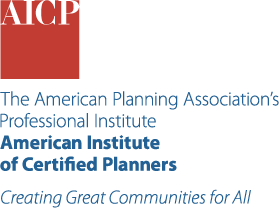Looking for education on this topic?
Check Out Our Passport Courses
Passport is your ticket to the training, experiences, and connections that will take you where you want to go in your planning career. Subscribe for unlimited access for one year to APA's extensive learning library of solution-oriented content facilitated by planners, for planners.
-
Multigenerational Planning: Theory and Practice
iQuaderni di Urbanistica Tre, 14: 17-23, 2017by: Mildred WarnerThis article lists the basic principles of multigenerational planning and urges planners to address the physical and social environment of a community when planning for youth and older adults. -
The Role of the Built Environment in the Disablement Process
American Journal of Public Health 95(11): 1933-1939, 2005by: Philippa Clarke, Linda GeorgeThis article introduces the Disablement Process model and examines the relationship between the built environment and physical function in older adults. -
Neighborhood Evaluations by City and Suburban Children
Journal of the American Planning Association 47(4): 458-466, 2007by: Willem Van VlietThis JAPA article asks children, rather than parents, their neighborhood preferences and compares the results demographically and spatially. -
Passing the Planning Mic to the Next Generation, Today
Next City, October 2018by: Serena DanielsThis article features a youth engagement strategy in the Warrendale-Cody Rouge area of Detroit, Michigan. -
Toronto Releases Planning Guidelines Focused on Kids
Next City, May 2017by: Rachel DoveyThis article discusses Toronto’s Planning for Children in New Vertical Communities, an effort to make the city more age-friendly for youth. -
Age-Friendly Sullivan: Perspectives from a Rural County
January 2018by: Erin Tou, Rachel SteinThis case study of Sullivan County, New York examines the challenges and opportunities related to senior and youth services in a rural context. -
Livable Communities for All Ages Brochure
2010by: Partners for Livable CommunitiesThis fact sheet introduces the benefits of age-friendly interventions in Housing, Transportation, Workforce Development, and Civic and Cultural Engagement/Lifelong Learning. -
Traffic Calming: A Livability Fact Sheet
2014by: AARP, Walkable and Livable Communities InstituteThis fact sheet aims to help communities embrace traffic calming as an age-inclusive transportation intervention. -
Road Diets: A Livability Fact Sheet
2014by: AARP, Walkable and Livable Communities InstituteThis fact sheet aims to help communities embrace road diets as an age-inclusive transportation intervention. -
Density: A Livability Fact Sheet
2014by: AARP, Walkable and Livable Communities InstituteThis fact sheet aims to help communities embrace density as an age-inclusive planning intervention. -
Crawlable Urbanism: Cities Are for Kids, Too
Streesblog USA, August 13, 2013by: Tanya SnyderThis blog post discusses the trend of young adults staying in cities to raise children. -
Planning for Family Friendly Communities: Village of Lombard, Illinois
2009by: Kathleen Hoover, Kevin McaveyThis case study shares how Lombard, Illinois has worked to become more family-friendly through public art, parks and recreation, and full-day kindergarten. -
Planning for Family Friendly Communities: City of Trenton, New Jersey
2009by: Kevin McaveyThis case study tracks Trenton, New Jersey’s effort to promote its reputation as a family-friendly community in the context of cultural diversity and economic challenges. -
A Framework for Assessing Aging in Place Technologies
February 2011by: Amber JoplinThis recorded webinar discusses how to assess aging in place technologies using individual, cultural, health, economic, legal, infrastructure, and environmental approaches. -
Better Transportation for Older Adults
2015by: Isabel Rovira, Renee Ray, AICP, Amy St PeterThis recorded webinar discusses how different transportation modes can be used to address the needs of older adults, including public transportation, ride shares, and walking, and explores public and private funding opportunities. -
Aging Friendly Communities
2012by: Amanda Lehning, Jana Lynott, AICPThis recorded webinar frames the growth of America’s older adults as an opportunity to open a dialogue about age-friendly communities. -
Age-Friendly Communities
2013by: Margaret Neal, Jana Lynott, AICP, Dorian BlockThis recorded webinar introduces the AARP Network of Age-Friendly Communities and the World Health Organization’s Global Network of Age-Friendly Cities and Communities. -
WHO/IFA Webinar 6 - Engaging Planners as Livable Communities Allies
February 2018by: Stephanie Krone Firestone, Laura Keyes, AICPThis recorded webinar shares the process of creating Livable Communities for All Ages (LCA), a fact sheet by Partners for Livable Communities. -
Age-Friendly Municipality: Guide to Implementing the Age-Friendly Municipality Initiative
2013by: Government of QuebecThis guide is designed to help municipalities in Quebec, Canada, implement the province’s Age-Friendly Municipality Initiative. -
DVRPC, DE, Age-Friendly Communities: Municipal Implementation Tool #30
November 2017by: Delaware Valley Regional Planning CommissionThis guide is designed to help municipalities in Greater Philadelphia foster age-friendly communities. -
TED: Building Age-Friendly Communities
2014by: Samir SinhaThis video features a geriatrician sharing his thoughts on how to build age-friendly communities that respect older adult’s desire for independence and aging-in-place. -
IMAGE:NYC
2016This interactive map of New York City, an initiative of Age-friendly NYC, allows users to view demographic data alongside available services and resources. -
AARP Livable Communities
2019This interactive map contains AARP’s Network of Age Friendly States and Communities (NAFSC) and Community Challenge Grant Awardees. -
Age-Friendly Communities Empower Seniors
October 2017by: Margaret DentonThis video focuses on applying the age-friendly framework to address mobility challenges. -
Cobb County, GA, Comprehensive Plan
Adopted November 2017The county’s comprehensive plan includes a section on Senior Services in its Human Services chapter. -
Hyattsville, MD, Action Plan to Increase Age Friendliness
Adopted January 2019This functional plan focuses on improving housing, health and safety, home- and community-based services, and communications and information to make the community more age-friendly. -
Bangor, ME, Livable Communities Action Plan
Adopted July 2018This functional plan uses the WHO’s eight domains of livability framework to structure its discussion and recommendations for creating an age-friendly community. -
Policies and Programmes Supporting Intergenerational Relations
2012by: Donna Butts, Leng Leng Thang, Alan Hatton YeoThis report challenges the traditional age-based approach to policy and program design and advocates for a more intergenerational approach. -
Age-Friendly Communities: Go Big or Go Home
Public Policy & Aging Report, 25(1): 30-33, 2015by: Kathryn LawlerThis article reveals several challenges in the age-friendly community movement, including scope, evaluation, and implementation. -
Checklist of Essential Features of Age-Friendly Cities
2007by: World Health OrganizationThis guide provides a checklist of essential features for communities to track their progress towards becoming age-friendly, organized by the World Health Organization’s 8 domains of livability. -
Berkshire County, MA, Age Friendly Berkshires Action Plan
Adopted November 2017This functional plan sets goals for each of the WHO’s eight domains of livability. -
Building Age-Friendly Communities
2015This video features older adults sharing what they want in an age-friendly community. -
Better Together: A Comparative Analysis of Age-Friendly and Dementia Friendly Communities
March 2016by: Natalie Turner, Lydia MorkenThis report explores the relationship between age-friendly and dementia friendly community building strategies and advocates for a more integrated approach. -
Paris, ME, Age Friendly Community
Adopted April 2018This functional plan addresses the current age-friendly work being done in the town and proposes goals, objectives, and actions for each of the WHO’s eight domains of livability. -
Livable Community Indicators for Sustainable Aging in Place
March 2013by: Amanda Lehning, Annie HarmonThis report proposes a list of indicators that local governments can use to examine how well older adults can age in place. -
Sausalito, CA, Age Friendly Sausalito
2016This functional plan lists strategies, outputs, responsible agencies, and indicators for each of the WHO’s eight domains of livability. -
Aging in Every Place: Supportive Service Programs for High and Low Density Communities
March 2014by: Janet Viveiros, Maya BrennanThis briefing paper highlights successful supportive service programs that are helping older adults age in place in dense, less dense, and sparsely populated neighborhoods. -
Child Care and Community Development
April 2010by: Kristen Anderson, Ellen DektarThis report emphasizes the social, economic, and environmental benefits of a robust childcare and early education network. -
Age Friendly Communities
2013This web page provides a step-by-step guide for mobilizing stakeholders to build an age-friendly community. -
AARP Livable Communities
Updated 2019This web page contains several resources related to AARP’s Livable Communities initiative. -
Age-Friendly Communities
Updated 2019This web page discusses how to make a community more friendly for aging in place. -
Long-Range Planning for Health, Equity & Prosperity: A Primer for Local Governments
December 2019by: Erik CallowayThis guide is designed to help planners promote health equity through long-range planning processes. -
Ethics, Equity and Social Justice Roles and Implications of Planners
Planning Webcast Series, September 2014by: Victor Rubin, Anita Hairston, AICPThis recorded webinar examines the responsibility of planners to work towards economic and social equity as outlined in the AICP Code of Ethics. -
Equitable Development
2018by: Sunny Widmann, Adam KentThis video features a conversation with Senior Program Officer Adam Kent from the D.C. office of Local Initiatives Support Corporation on equitable development. -
Introducing the National Equity Atlas
December 2014by: Sarah Treuhaft, Justin ScogginsThis recorded webinar tours the National Equity Atlas, a data and policy resource developed by PolicyLink and the Program for Environmental and Regional Equity at University of Southern California. -
Historian Says Don't "Sanitize" How Our Government Created Ghettos
2015by: Richard RothsteinThis audio recording with Richard Rothstein addresses the legacy of government-sponsored segregation in America’s cities. -
Food Access Research Atlas
2019by: Michele Ver PloegThis interactive map uses supermarket accessibility data to show which census tracts are low access at different distances. -
11th Street Bridge Park - Equitable Development Task Force
2015by: 11th Street Bridge ParkThis video highlights the work of the Equitable Development Task Force, part of the 11th Street Bridge Park project in Washington D.C. -
SEEDoc New Mexico: Interview Highlights, Jamie Blosser and Tomasita Duran
2012by: Jamie Blosser, Tomasita DuranThis video discusses the process of rehabilitating the pueblo in Ohkay Owingeh, New Mexico. -
PolicyMap
2019This interactive map allows users to visualize demographic, income, housing, lending, quality of life, economic, education, health, and other variables nationally.


